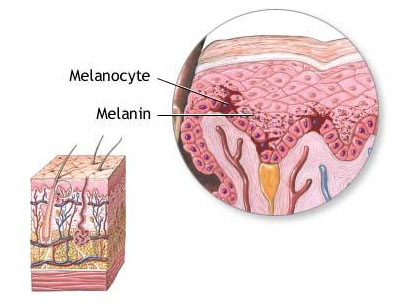Melanocyte
(Redirected from Melanocytic)
Melanocytes[edit | edit source]
Introduction[edit | edit source]
Melanocytes are specialized cells located in the skin and eyes, known for producing and containing the pigment melanin. This pigment is responsible for giving color to the skin, hair, and eyes, and plays a crucial role in protecting the skin from ultraviolet (UV) radiation.
Anatomy and Function[edit | edit source]
Location and Structure[edit | edit source]
Melanocytes are found in the epidermis, the outermost layer of the skin, and in the eye's uveal tract. They have long dendritic processes that extend to the surrounding keratinocytes, allowing the transfer of melanin.
Melanin Production[edit | edit source]
Melanin is synthesized within melanocytes through a process called melanogenesis. This process is influenced by genetic factors, exposure to sunlight, and hormonal changes.
Types of Melanin[edit | edit source]
There are two main types of melanin:
- Eumelanin: Provides brown to black pigment and offers protection against UV radiation.
- Pheomelanin: Gives a red or yellow color and is less effective in protecting against UV radiation.
Role in Skin Color and Sun Protection[edit | edit source]
Melanin's primary function is to absorb and dissipate UV radiation, protecting the DNA in skin cells from UV-induced damage. The amount and type of melanin determine an individual's skin color.
Melanocyte Disorders[edit | edit source]
Hyperpigmentation[edit | edit source]
Conditions like melasma or freckles are caused by increased melanin production.
Hypopigmentation[edit | edit source]
Conditions such as vitiligo and albinism result from reduced melanin production or absence of melanocytes.
Melanoma[edit | edit source]
Melanoma is a serious form of skin cancer that originates in melanocytes.
Diagnostic Methods[edit | edit source]
Melanocyte-related disorders are diagnosed using techniques such as:
- Dermatoscopy
- Skin biopsy
- Genetic testing (especially in cases of albinism)
Treatment and Management[edit | edit source]
Treatment depends on the specific condition and may include:
- Topical creams for hyperpigmentation
- Phototherapy for vitiligo
- Surgical and medical treatments for melanoma
References[edit | edit source]
External Links[edit | edit source]
Search WikiMD
Ad.Tired of being Overweight? Try W8MD's physician weight loss program.
Semaglutide (Ozempic / Wegovy and Tirzepatide (Mounjaro / Zepbound) available.
Advertise on WikiMD
|
WikiMD's Wellness Encyclopedia |
| Let Food Be Thy Medicine Medicine Thy Food - Hippocrates |
Translate this page: - East Asian
中文,
日本,
한국어,
South Asian
हिन्दी,
தமிழ்,
తెలుగు,
Urdu,
ಕನ್ನಡ,
Southeast Asian
Indonesian,
Vietnamese,
Thai,
မြန်မာဘာသာ,
বাংলা
European
español,
Deutsch,
français,
Greek,
português do Brasil,
polski,
română,
русский,
Nederlands,
norsk,
svenska,
suomi,
Italian
Middle Eastern & African
عربى,
Turkish,
Persian,
Hebrew,
Afrikaans,
isiZulu,
Kiswahili,
Other
Bulgarian,
Hungarian,
Czech,
Swedish,
മലയാളം,
मराठी,
ਪੰਜਾਬੀ,
ગુજરાતી,
Portuguese,
Ukrainian
Medical Disclaimer: WikiMD is not a substitute for professional medical advice. The information on WikiMD is provided as an information resource only, may be incorrect, outdated or misleading, and is not to be used or relied on for any diagnostic or treatment purposes. Please consult your health care provider before making any healthcare decisions or for guidance about a specific medical condition. WikiMD expressly disclaims responsibility, and shall have no liability, for any damages, loss, injury, or liability whatsoever suffered as a result of your reliance on the information contained in this site. By visiting this site you agree to the foregoing terms and conditions, which may from time to time be changed or supplemented by WikiMD. If you do not agree to the foregoing terms and conditions, you should not enter or use this site. See full disclaimer.
Credits:Most images are courtesy of Wikimedia commons, and templates, categories Wikipedia, licensed under CC BY SA or similar.
Contributors: Kondreddy Naveen

